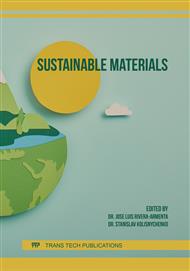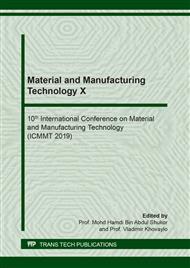[1]
X. Zhu et al., Sustainable activated carbons from dead ginkgo leaves for supercapacitor electrode active materials,, Chem. Eng. Sci., vol. 181, p.36–45, (2018).
DOI: 10.1016/j.ces.2018.02.004
Google Scholar
[2]
A. J. S. Ahammad et al., Porous tal palm carbon nanosheets: preparation, characterization and application for the simultaneous determination of dopamine and uric acid,, Nanoscale Adv., (2019).
DOI: 10.1039/c8na00090e
Google Scholar
[3]
A. A. Mohammed, C. Chen, and Z. Zhu, Low-cost, high-performance supercapacitor based on activated carbon electrode materials derived from baobab fruit shells,, J. Colloid Interface Sci., vol. 538, p.308–319, (2019).
DOI: 10.1016/j.jcis.2018.11.103
Google Scholar
[4]
W. C. Lim, C. Srinivasakannan, and N. Balasubramanian, Activation of palm shells by phosphoric acid impregnation for high yielding activated carbon,, J. Anal. Appl. Pyrolysis, vol. 88, no. 2, p.181–186, (2010).
DOI: 10.1016/j.jaap.2010.04.004
Google Scholar
[5]
I. I. Misnon, N. K. M. Zain, and R. Jose, Conversion of Oil Palm Kernel Shell Biomass to Activated Carbon for Supercapacitor Electrode Application,, Waste and Biomass Valorization, vol. 0, no. 0, p.1–10, (2018).
DOI: 10.1007/s12649-018-0196-y
Google Scholar
[6]
M. S. Choi, S. Park, H. Lee, and H. S. Park, Hierarchically nanoporous carbons derived from empty fruit bunches for high performance supercapacitors,, vol. 25, p.103–112, (2018).
Google Scholar
[7]
F. N. ANI, Sustainable Biofuels and Other Related Bio-Products from Palm Cultivations,, MATEC Web Conf., vol. 77, p.1–4, (2016).
DOI: 10.1051/matecconf/20167711005
Google Scholar
[8]
K. Wang et al., Promising biomass-based activated carbons derived from willow catkins for high performance supercapacitors,, Electrochim. Acta, vol. 166, p.1–11, (2015).
DOI: 10.1016/j.electacta.2015.03.048
Google Scholar
[9]
A. Nayak, B. Bhushan, V. Gupta, and P. Sharma, Journal of Colloid and Interface Science Chemically activated carbon from lignocellulosic wastes for heavy metal wastewater remediation : Effect of activation conditions,, J. Colloid Interface Sci., vol. 493, p.228–240, (2017).
DOI: 10.1016/j.jcis.2017.01.031
Google Scholar
[10]
I. I. Misnon et al., High performance MnO 2 nano fl ower electrode and the relationship between solvated ion size and speci fi c capacitance in highly conductive electrolytes,, vol. 57, p.221–230, (2014).
DOI: 10.1016/j.materresbull.2014.05.044
Google Scholar



